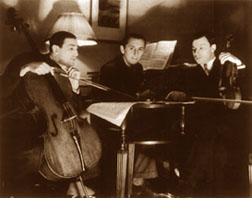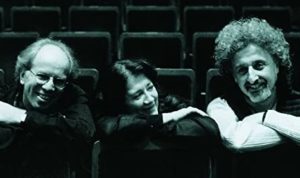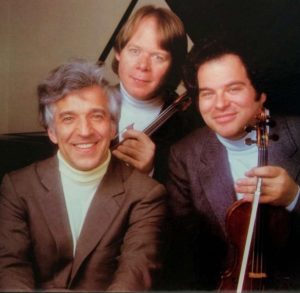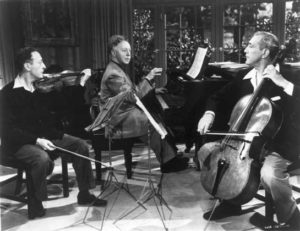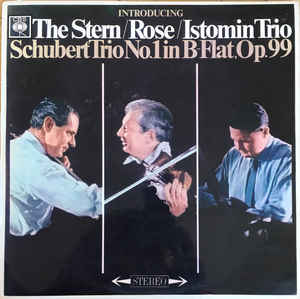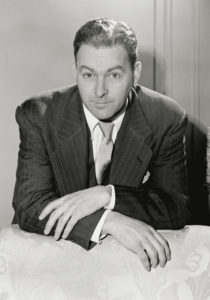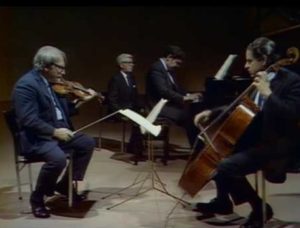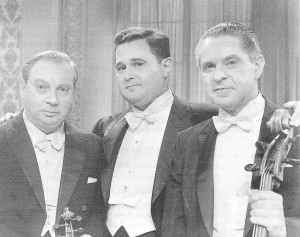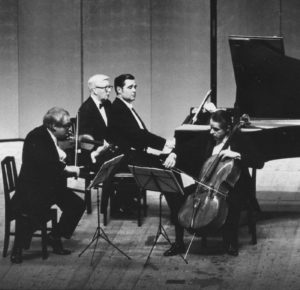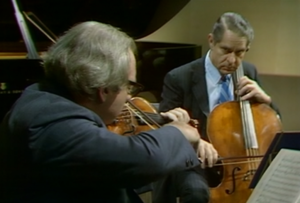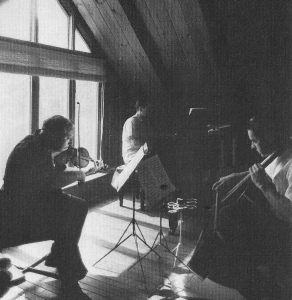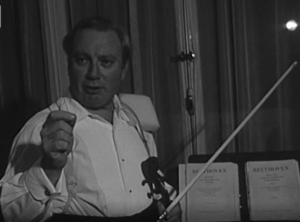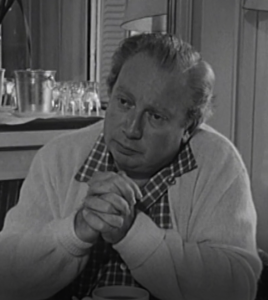Establishing a trio is not easy for great soloists, either humanly or musically! Failures are almost as numerous as attempts. One of the most spectacular was that of Horowitz, Milstein and Piatigorsky, who despite being great friends, working together on a regular basis and sharing the same manager, gave up forever after a frustrating concert given at Carnegie Hall in 1932. More recently Argerich, Kremer, and Maïsky, who have performed and recorded so often together in duos, also abandoned the project of forming a trio.
The sonata is a dialogue, whereas the quartet is either a democracy – or a dictatorship imposed by the first violin. The trio is by its very nature a constant source of conflict and imbalance. A permanent ensemble of chamber musicians can certainly agree on a modus vivendi and remain together for a long time. Nevertheless, it goes without saying that three great soloists are required to render complete justice to this repertoire. The problem is that great soloists are used to affirming their own ideas in recitals and concertos without being contradicted. But as a trio, they must unify their conceptions into a coherent interpretation, which presupposes solid musical and human affinities and demands a lot of rehearsing!
There are countless cases of improvised or newly- established trios who thought they would get along well, but who ended up by tearing each other apart. Economically and psychologically, the situation is also a delicate one. Three major soloists who embark on the adventure of creating a trio stand to lose a considerable amount of money, as they must both significantly reduce their usual fees and give up other engagements in order to prepare and rehearse. Becoming a “chamber musician”, even for limited periods of time, poses ego and career problems. For cellists, the prospect can still have positive aspects, as they are less sought after than their piano and violin colleagues, and their concerto repertoire is not as extensive. For violinists, it is a slightly more delicate, but they can hope to prove that they are “real” musicians, in the same way that an operatic tenor might decide to turn also to singing lieder. For pianists, however, there is a great danger. Given the immensity of the pianists’ repertoire and the wide market, public, critics and organizers alike all tend to think that a pianist decides to make chamber music only because his solo career is in decline. Today, the situation has changed, and it seems quite natural that soloists also play chamber music, but in the 50s and 60s, when the Istomin-Stern-Rose Trio was launched, it was a narrow path to tread, especially in the United States where the star system was omnipresent and appreciation of chamber music was quite weak.
The clash of egos
Arthur Rubinstein told a very funny story about the trio (quickly baptized as the One Million Dollar Trio) in which he briefly performed with two other superstars – Heifetz and Piatigorsky:
“These concerts remind me of a funny little quarrel with Heifetz. He bitterly resented that all publicity bore the names Rubinstein, Heifetz, Piatigorsky – always in the same order. “Why can’t we change it and give each one of us a chance to be the first-named?” said Jascha.
“I couldn’t care less,” I answered indifferently, “but as far as I know, all trios are published for piano, violin, and violoncello, and it is the tradition to publicize the players in this order.”
Jascha didn’t want to give in so soon. “I have seen some trios printed for violin and violoncello, accompanied by the piano,” he said.
“They must have been printed by yourself, Jascha.”
“What do you mean?” he said indignantly. “I’ve really seen them.”
I began to see red. “Jascha,” I shouted, “if God played the violin, it would be printed Rubinstein, God, and Piatigorsky.” No reply from Jascha.”
It is a subject of conflict that has not spared any of the great trios in history, and naturally there were incidents and disputes of this nature between Istomin and Stern. Rubinstein was right to point out that the custom is to put the pianist first, followed by the violinist and the cellist, because the works are entitled that way. The order of the members of the Cortot-Thibaud-Casals trio was never changed on the pretext that Casals was the most famous of the three. However, the normal order of members of the Trio formed by Istomin, Stern and Rose was often changed, in general by putting Stern’s name at the top of the list and on occasion by even calling it the Stern Trio.
The initiative could come from the organizers, the journalists, or Columbia itself, but the one factor in common was that all parties involved were hoping to arouse more interest or earn more money. Stern’s fan lobby was also very pushy. From the first cycle of concerts given by the Trio in New York in 1962, Irving Kolodin suggested in the Saturday Review that it be called the SIR Trio (“to identify them both by their rank and their initials”). Kolodin tried again in the Beethoven Year, planning to discreetly entitle his three-page article The Stern Trio, which was due to be published on the eve of the highly mediatized Carnegie Hall series and coincide with the publication of the complete boxed set of the Trios! Last-minute editing avoided a potential drama by giving it a humorous title, Three Men on a Hobby, named after the well-known humorous travelogue by Jerome K. Jerome entitled Three Men on a Boat.
Istomin paid so much attention to this point because he had so much more to lose. As a member of the Trio, he was already at risk of being labelled as a chamber musician, but if his name did not appear in the customary first position or, even worse, if the Trio were to be re-named the Stern Trio, he would be considered as an “accompanist” and his solo reputation and career could have been severely damaged. On this question, Rose always remained rather neutral, as in any case his name appeared last, but Stern was not always very clear. He was aware of the difficulties this would engender for Istomin, but at times, he would allow things to happen and intervened only when Istomin became angry.
Aside from the issue of the Trio’s name, there was the problem of protocol, which became even more delicate during the Beethoven tours in 1970. Istomin proposed setting a rule which would avoid problems during the long series of upcoming concerts: he himself would enter the stage first for the trios, and second for the duets. As there are eleven trios, ten Sonatas with violin, and nine Sonatas or Variations with cello, the proposal seemed quite reasonable – but his two colleagues reacted with vehement opposition, undoubtedly because it is often the trios which end the programs and are the highlight of the event. Rose was furious, and openly sabotaged the first night. Tensions ran high, but in the end, the protocol submitted by Istomin was adopted to the general satisfaction of all members.
The preponderance of the piano
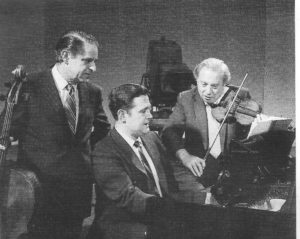 The pre-eminence of the piano is not only a question of the listed order on the score but is above all a musical issue! In an interview with Irving Kolodin for Saturday Review, Istomin reminds one in blunt terms: “It’s simply too tempting if you’re a pianist not to think in pianistic terms… I have the feeling that the other instruments are his friends, his relatives, his beloveds, but the piano is Beethoven himself. I have observed, too, that when a performance fails, it is invariably through a failure in the piano part. I or any other artist who has that responsibility in the piano part, simply by the trunk or frame of the works that he has in his hands, can place a solid base for a performance, so that even if the other instrument or instruments are not quite in top form, a strong performance on the part of the pianist can save it. But, if the pianist fails, no matter how beautifully the violinist or the cellist might play, I think that the performance will not hold up.”
The pre-eminence of the piano is not only a question of the listed order on the score but is above all a musical issue! In an interview with Irving Kolodin for Saturday Review, Istomin reminds one in blunt terms: “It’s simply too tempting if you’re a pianist not to think in pianistic terms… I have the feeling that the other instruments are his friends, his relatives, his beloveds, but the piano is Beethoven himself. I have observed, too, that when a performance fails, it is invariably through a failure in the piano part. I or any other artist who has that responsibility in the piano part, simply by the trunk or frame of the works that he has in his hands, can place a solid base for a performance, so that even if the other instrument or instruments are not quite in top form, a strong performance on the part of the pianist can save it. But, if the pianist fails, no matter how beautifully the violinist or the cellist might play, I think that the performance will not hold up.”
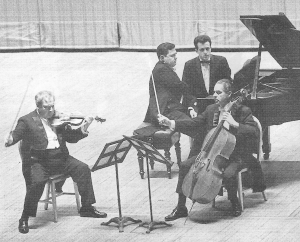 Istomin is equally compelling about the supposedly delicate question of the balance: “What counts here in the attention one pays to the musical material at hand and to the development of lines and phrases? I have no compunction in overwhelming, sometimes overbalancing, a partner in a given situation if I feel that a climax or a crescendo would be aborted by my lessening drive and propulsion. At the same time, when I am musically compelled to submerge myself, I of course will. This presents a technical problem in the control of sonorities. The object in all music-making is to make the composer’s ideas clear – that is the whole thing, whether in solo or chamber music. When I am required by musical necessities to come down, I will. And when I am required to go up, at whatever cost, I will. That’s my idea of balance.”
Istomin is equally compelling about the supposedly delicate question of the balance: “What counts here in the attention one pays to the musical material at hand and to the development of lines and phrases? I have no compunction in overwhelming, sometimes overbalancing, a partner in a given situation if I feel that a climax or a crescendo would be aborted by my lessening drive and propulsion. At the same time, when I am musically compelled to submerge myself, I of course will. This presents a technical problem in the control of sonorities. The object in all music-making is to make the composer’s ideas clear – that is the whole thing, whether in solo or chamber music. When I am required by musical necessities to come down, I will. And when I am required to go up, at whatever cost, I will. That’s my idea of balance.”
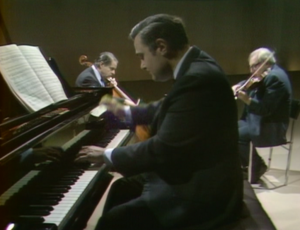 In a long article by Robert Jacobson published in May 1972 by High Fidelity, Istomin seized the opportunity to further expand upon his ideas: “It is not the piano in chamber music that must adjust, but the strings to the piano … Apart from the obvious fact that the bulk of the musical material is given to the piano in this repertory, there is the simple technical fact of the well-tempered scale, to which string instruments must adjust, and the built-in articulation of the piano. The string notes run into each other when the piano plays with them, there tends to be relative inarticulation with strings – and you cannot have the piano remove its percussiveness. Besides, one of the great strengths of the piano in all music making is its articulation. And many string players do not play with this in mind. Of course, the great father of us all in this regard – the first man conscious of the problem – was Casals who recognized this question of articulation. And my colleagues realize this, because there were only a few times when they felt that I and the piano were over- balancing them. Sometimes they asked for more piano – especially to keep the beat under their own playing.” “Admittedly, there are registers on the violin and the cello less capable of cutting through than others, and there are times when I have to play piano when it is written forte… I’m the one who must make these choices and compromises – the way a conductor interweaves the brass and strings with the singers in Wagner and Strauss.”
In a long article by Robert Jacobson published in May 1972 by High Fidelity, Istomin seized the opportunity to further expand upon his ideas: “It is not the piano in chamber music that must adjust, but the strings to the piano … Apart from the obvious fact that the bulk of the musical material is given to the piano in this repertory, there is the simple technical fact of the well-tempered scale, to which string instruments must adjust, and the built-in articulation of the piano. The string notes run into each other when the piano plays with them, there tends to be relative inarticulation with strings – and you cannot have the piano remove its percussiveness. Besides, one of the great strengths of the piano in all music making is its articulation. And many string players do not play with this in mind. Of course, the great father of us all in this regard – the first man conscious of the problem – was Casals who recognized this question of articulation. And my colleagues realize this, because there were only a few times when they felt that I and the piano were over- balancing them. Sometimes they asked for more piano – especially to keep the beat under their own playing.” “Admittedly, there are registers on the violin and the cello less capable of cutting through than others, and there are times when I have to play piano when it is written forte… I’m the one who must make these choices and compromises – the way a conductor interweaves the brass and strings with the singers in Wagner and Strauss.”
When Jacobson asked him about the possibility of playing with the piano lid half-open, Istomin replied that the difference in sound volume would be very small, but that the piano would lose a great deal of clarity and sound quality. He also stated that the sound produced by Stern and Rose was also very powerful and that they were capable of drowning out the piano, and ended by pointing out that the perception of sound was something quite relative: “One sees the piano open and feels it will overwhelm. It’s funny, pianists come backstage and say to me that the performance could have stood more piano; violinists tell Isaac they heard only piano and cello; and cellists tell Rose they heard only piano and violin. People hear what they want to hear. Having the lid at half-mast is the easy way out. It doesn’t make Isaac Stern any less a great violinist to concede that while being unique and indispensable, the piano is the center of the piano trio, especially in Beethoven – it was his instrument, it’s all piano music and the music was published as ‘Pianoforte pieces with…'” A few years later, in an interview with John Tibbetts, Istomin would use the same words about the Brahms trios: “The piano has at least half of the speech. It should not be forgotten that the piano has twice as much to play. The piano is Brahms!”
The string players’ standpoint
Questioned by Jacobson, Leonard Rose acknowledged that there were problems of balance in some of the halls but that they could deal with them: “You can’t emaciate the piano writing, because its strength is important. The manner in which we play is more like soloists projecting. We sock it out. We have to. The piano has oceans of sound and Eugene is fortunate we have healthy sounds to match his.”
As for Isaac Stern, he stated that the problem of balance was “a challenge for the three of us. Beethoven thought from the position of the piano, yes, but also in a total concept. Pianists are fond of pointing out the piano-violin-cello listing – but the fact is that in the sonatas the string instrument also has an enormous role to play, not out of proportion to the piano.” Stern also stressed the considerable evolution of instruments: modern pianos are much more powerful than those of Beethoven’s time, while stringed instruments are the same, simply enhanced by the use of metal strings. He believed that there was a real risk that a pianist could drown out his partners, but he was quick to acknowledge that “Istomin has such a sense of sound – he plays the piano like a bowed stringed instrument – that there is an absolute sense of balance musically.”
Istomin admitted to Jacobson that after the intense work they had put into building up their repertoire, they scarcely rehearsed due to lack of time, but that in any case, it wasn’t necessary. Each member was able to react very quickly to an inflection or initiative put forth by a partner. Many performance options were made on stage: “The exciting thing is the spontaneous combustion that takes place, the freshness of the performance, no matter how often we play together. Yes, there were cases of serious differences and even though they were minute, infinitesimal, we took them seriously. But you have to compromise.”
Conflict as a driving force
What happened when there was a musical disagreement between the members of the Trio – who would decide? All three were quick to specify that musical disagreements were rare, but that if confronted with a problematical passage, it was assumed that the musician in charge of the melody line would make the final decision and impose his viewpoint on the other two. But in reality, from time to time, a small detail gave rise to a major dispute. Istomin recognized this and justified it by explaining: “When you try to achieve something on a high level, it has to be absolutely authoritarian. Art is not a democracy, but a kind of aesthetic autonomy.” It is the musical side of the clash of egos, to which must be added the human side!
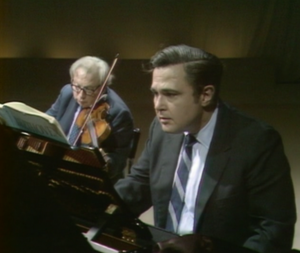 Robert Jacobson entitled his article in the magazine High Fidelity, The Intellectual, The Gambler and the Corporate Man. The subtitle was: “How can three well-known virtuosos curb their egos to form a harmonious trio?” That was the big question. Given the constant tension and the quite frequent disputes, one begins to wonder whether this does not in fact correspond to an absolute necessity! Istomin pointed out: “It is really the conflict that produces music, not unanimity of personalities.” Stern went even further: “Let’s face it: If you don’t have a strongly personal viewpoint, you don’t have an artistic viewpoint.” The best proof is that this had no obvious detrimental consequences on their playing, even when a quarrel broke out during the concert!
Robert Jacobson entitled his article in the magazine High Fidelity, The Intellectual, The Gambler and the Corporate Man. The subtitle was: “How can three well-known virtuosos curb their egos to form a harmonious trio?” That was the big question. Given the constant tension and the quite frequent disputes, one begins to wonder whether this does not in fact correspond to an absolute necessity! Istomin pointed out: “It is really the conflict that produces music, not unanimity of personalities.” Stern went even further: “Let’s face it: If you don’t have a strongly personal viewpoint, you don’t have an artistic viewpoint.” The best proof is that this had no obvious detrimental consequences on their playing, even when a quarrel broke out during the concert!
Stern appeared to be the most accommodating of the three and was the only one who gave in gracefully in a discussion, but he was also the one who had the most to be forgiven for! If he willingly compromised in rehearsal, it was also because he often arrived poorly prepared, which was highly upsetting for Istomin. During the Beethoven cycles, the first rehearsals of the Violin Sonatas were difficult. Of course, improvements followed quickly, but it created a sense of unnecessary tension. Rose exploded from time to time, blaming him for not practicing enough and for trying to keep up too many concertos in his repertoire.
Less serious but equally devastating was Stern’s mania for arriving late. John Trapp, who participated in all the tours during the Beethoven year, and who oversaw the travel arrangements in addition to page turning for Istomin, reported Stern’s delays in his diary with caustic humor: “Isaac was due at one p.m., so he arrived at two-thirty for the Kreutzer rehearsal”; “The lunch was at one o’clock. At twenty past one, Isaac was still here (at the hotel), which reminds me that he even kept President Kennedy waiting ten minutes when the Trio played at the White House. He’s absolutely incorrigible and incurable.” On the day of the concert, he invariably arrived at the last minute and never warmed up, which irritated his partners intensely and inevitably harmed the performance of the first work in the program. On occasion, he even arrived so late and tired from his many activities that he lacked concentration, which caused his playing to suffer. Another one of Stern’s bad habits was forgetting his scores at the hotel (around ten times during the Beethoven tours). Stern also often indulged in showing off, interrupting his colleagues during interviews or press conferences and managing to monopolize the attention of the media and the public. At the 1962 White House concert, he addressed President Kennedy with such authority, breaking the protocol, that Kennedy thanked Stern and his “accompanists”.
Thornton Trapp multiplies the anecdotes: “Still, he has an unmistakable talent for capturing the public eye. At the opening of the New York cycle, he managed to break a string during the first moments of the Ghost Trio. At another concert he dropped his bow. Sometimes he accumulated the exploits, as in London when he realized five minutes before the beginning of the concert that he had forgotten his scores. The program was hastily changed, Istomin and Rose playing first. Then Stern broke a string: “He leapt off the stage, snatched his other already tuned fiddle and leapt back on the stage in about twenty-three seconds flat.”
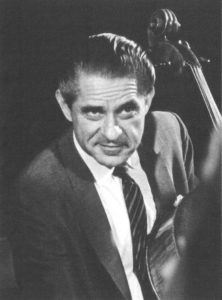 For the external observers of the Trio, Leonard Rose appeared to be the most stable personality (the Corporate Man, as Jacobson named him), but in reality this was not the case. He had been deeply traumatized by the incurable illness of his first wife, who died in 1964 after eight years of struggle. He remarried immediately afterwards, but lived an increasingly more withdrawn life, obsessed with the search for perfection and the fear of failure. His need for recognition remained very strong, and his mood was frequently unstable, alternating between anger, nervous outbursts and moments of great generosity.
For the external observers of the Trio, Leonard Rose appeared to be the most stable personality (the Corporate Man, as Jacobson named him), but in reality this was not the case. He had been deeply traumatized by the incurable illness of his first wife, who died in 1964 after eight years of struggle. He remarried immediately afterwards, but lived an increasingly more withdrawn life, obsessed with the search for perfection and the fear of failure. His need for recognition remained very strong, and his mood was frequently unstable, alternating between anger, nervous outbursts and moments of great generosity.
Conclusions
One of the most judicious insights to be found about the Istomin-Stern-Rose Trio adventure are those of Trapp, who attended so many concerts and rehearsals and who was witness to countless everyday moments during the life of the Trio: “It is somewhat ironic that the three need each other in so many ways. For instance, Lenny and Isaac couldn’t replace Eugene for there is no other artist able and willing to do what he does. Eugene and Lenny need Isaac’s popularity for bookings, which only Isaac could make. Artistically, Eugene having learned so much from early years with Casals and Busch, has so much to give to Isaac, who after some resistance will perhaps accept it, and much to teach Lenny as well. But Lenny will resist tuition, at least from Eugene, whose manner probably makes it difficult for Lenny – though sometimes he will accept a little suggestion which comes to him by way of Isaac. But whatever divides them is at the moment not as strong as that which unites them.”
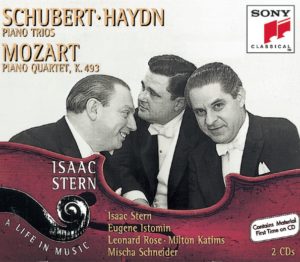 In 1990, with the benefit of hindsight, Eugene Istomin corroborated: “I must say that while we laughed a lot, bickered and quarreled a bit – once or twice very seriously – our basic unity on musical ideals never wavered – nor did our capacity to attain that most intimate of communications that musicians can have with one another. When you have that, a lot of petty peeves are worth enduring.” .
In 1990, with the benefit of hindsight, Eugene Istomin corroborated: “I must say that while we laughed a lot, bickered and quarreled a bit – once or twice very seriously – our basic unity on musical ideals never wavered – nor did our capacity to attain that most intimate of communications that musicians can have with one another. When you have that, a lot of petty peeves are worth enduring.” .
Documents
Beethoven, Trio in B flat major Op. 97 “Archduke”. Eugene Istomin, Isaac Stern, Leonard Rose. Filmed in October 1970 by the French Television and issued on DVD by EMI Classic Archive.

